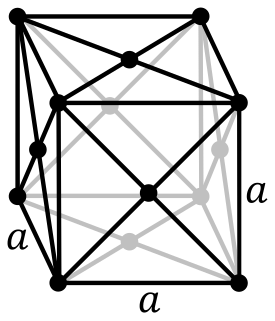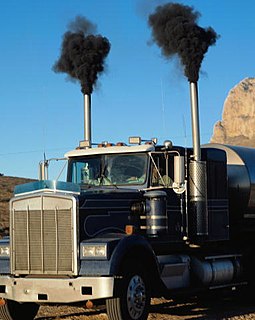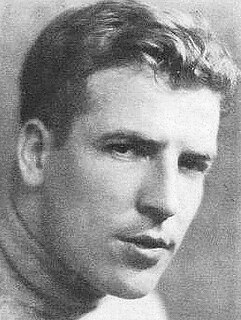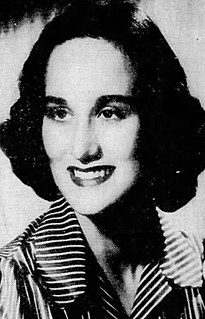
Ethylene (IUPAC name: ethene) is a hydrocarbon which has the formula C
2H
4 or H2C=CH2. It is a colorless flammable gas with a faint "sweet and musky" odor when pure. It is the simplest alkene (a hydrocarbon with carbon-carbon double bonds).
A methyl group is an alkyl derived from methane, containing one carbon atom bonded to three hydrogen atoms — CH3. In formulas, the group is often abbreviated Me. Such hydrocarbon groups occur in many organic compounds. It is a very stable group in most molecules. While the methyl group is usually part of a larger molecule, it can be found on its own in any of three forms: anion, cation or radical. The anion has eight valence electrons, the radical seven and the cation six. All three forms are highly reactive and rarely observed.

Oganesson is a synthetic chemical element with the symbol Og and atomic number 118. It was first synthesized in 2002 at the Joint Institute for Nuclear Research (JINR) in Dubna, near Moscow, Russia, by a joint team of Russian and American scientists. In December 2015, it was recognized as one of four new elements by the Joint Working Party of the international scientific bodies IUPAC and IUPAP. It was formally named on 28 November 2016. The name honors the nuclear physicist Yuri Oganessian, who played a leading role in the discovery of the heaviest elements in the periodic table. It is one of only two elements named after a person who was alive at the time of naming, the other being seaborgium, and the only element whose eponym is alive today.

Dudley Robert Herschbach is an American chemist at Harvard University. He won the 1986 Nobel Prize in Chemistry jointly with Yuan T. Lee and John C. Polanyi "for their contributions concerning the dynamics of chemical elementary processes". Herschbach and Lee specifically worked with molecular beams, performing crossed molecular beam experiments that enabled a detailed molecular-level understanding of many elementary reaction processes. Herschbach is a member of the Board of Sponsors of the Bulletin of the Atomic Scientists.

Shivaji University established in 1962, is a state university located at Kolhapur, Maharashtra, India. The university, with a campus spread over 853 acres (345 ha), is named after Chhatrapati Shivaji, founder of the Maratha Empire. It was inaugurated on 18 November 1962 by Sarvepalli Radhakrishnan, the then president of India. Yashwantrao Chavan and Balasaheb Desai took the lead in establishing this university. Educational institutions from Kolhapur, Sangli, and Satara districts come under its jurisdiction with 279 affiliated colleges and recognised institutes. One of the major objectives behind its foundation was to cater to the educational needs of South Maharashtra region. The University's efforts towards excellence are being recognised by the substantial grants received from funding agencies such as University Grants Commission (India), Department of Science and Technology (India), and DBT. The university is self reliant in water, which is stored on campus during the rainy season. It has a biodiversity-rich campus.
1,3-Butadiene is the organic compound with the formula (CH2=CH)2. It is a colorless gas that is easily condensed to a liquid. It is important industrially as a precursor to synthetic rubber. The molecule can be viewed as the union of two vinyl groups. It is the simplest conjugated diene.

Soot is a mass of impure carbon particles resulting from the incomplete combustion of hydrocarbons. It is more properly restricted to the product of the gas-phase combustion process but is commonly extended to include the residual pyrolysed fuel particles such as coal, cenospheres, charred wood, and petroleum coke that may become airborne during pyrolysis and that are more properly identified as cokes or char.

George Andrew Olah was a Hungarian chemist. After the Hungarian Revolution of 1956, he emigrated to the United Kingdom, which he left for Canada in 1964, finally resettling in the United States in 1965. His research involved the generation and reactivity of carbocations via superacids. For this research, Olah was awarded a Nobel Prize in Chemistry in 1994 "for his contribution to carbocation chemistry." He was also awarded the Priestley Medal, the highest honor granted by the American Chemical Society and F.A. Cotton Medal for Excellence in Chemical Research of the American Chemical Society in 1996. According to György Marx he was one of The Martians.
Michael Szwarc was a British and American polymer chemist who discovered and studied ionic living polymerization.

The aryl hydrocarbon receptor or dioxin receptor is a protein that in humans is encoded by the AHR gene. The aryl hydrocarbon receptor is a transcription factor that regulates gene expression. It was originally thought to function primarily as a sensor of xenobiotic chemicals and also as the regulator of enzymes such as cytochrome P450s that metabolize these chemicals. The most notable of these xenobiotic chemicals are aromatic (aryl) hydrocarbons from which the receptor derives its name.
The Integrated Media Systems Center (IMSC) is on the campus of the University of Southern California, United States. It was founded using a grant from the US National Science Foundation in 1996 for the study of Integrated Media Systems. The original mission was focused on the advancement the integration of digital video, immersive audio, text, animation and graphics to transform the way people work, communicate, learn, teach, entertain and play. By using cross-disciplinary programs of research and education, the Center has taken multimedia to a new level of technological sophistication.
Chulabhorn Research Institute is a biomedical and chemistry research institute in Bangkok, Thailand. Initiated by Princess Chulabhorn in 1987, it was established as an independent agency funded by the Thai government.
Larry Dalton is an American chemist best known for his work in polymeric nonlinear electro-optics. Recent accusations of academic dishonesty, including fabricating data, have led to increased attention on Dalton's work.
Peter John Stang is a German American chemist and Distinguished Professor of chemistry at the University of Utah. He was the editor-in-chief of the Journal of the American Chemical Society from 2002 to 2020.
G. K. Surya Prakash is a professor and holder of the George A. and Judith A. Olah Nobel Laureate Chair in Hydrocarbon Chemistry at the Department of Chemistry at the University of Southern California. He serves as the Director of the Loker Hydrocarbon Research Institute, where he maintains his prominent research lab. He also served as the Chairman of the Chemistry Department for four years between 2017-2021. He received a B.Sc. (Hons) from Bangalore University in 1972, a M.Sc. from IIT Madras in 1974 and a Ph.D. from University of Southern California in 1978 under the direction of George Olah, where he worked on characterizing stable carbocations in superacids. He also sits on several editorial boards of major scientific journals.

Karl Otto Christe is an inorganic chemist. He is the best reference in respectful handling of a huge number of extremely reactive components and his extensive experience in fluorine chemistry earned him the title of 'The Fluorine God'. His research covers fluorine chemistry of nitrogen and halogens and the synthesis of new energetic materials.
The Tolman Medal is awarded each year by the Southern California Section of the American Chemical Society (SCALACS) for outstanding contributions to chemistry which include contributions in areas of fundamental studies, chemical technology, and significant contributions to chemical education or outstanding leadership in science on a national level. To be eligible for the Medal, the recipient must have accomplished the majority of his or her work while resident in Southern California.

Don Terry was an American film actor, best known for his lead appearances in B films and serials in the 1930s and early 1940s. His best known role is probably playing the recurring character of Naval Commander Don Winslow in Universal Pictures serials of the early 1940s, including Don Winslow of the Navy (1942) and Don Winslow of the Coast Guard (1943).

The Beckman Institute at Caltech is a multi-disciplinary center for research in the chemical and biological sciences, located at and partnering with the California Institute of Technology (Caltech) in Pasadena, California, United States.

Katherine Loker was an American heiress and philanthropist. She donated tens of millions of dollars to fund university programs and infrastructure improvement at California State University, Dominguez Hills, Harvard University, and the University of Southern California (USC). She also made significant contributions to the California Museum of Science and Industry, the California Hospital Medical Center in Los Angeles, the Donald P. Loker Cancer Treatment Center, the Los Angeles Music Center, and the Richard Nixon Library in Yorba Linda, among other institutions. She was honored in 1996 with the Harvard Alumni Association Medal and in 2007 received the Presidential Medallion, the highest award of USC. Loker was awarded an honorary doctorate from USC in 1997 and an honorary Doctor of Humane Letters degree from the Harvard in 2000. In 1999, The New York Times spotlighted her leading role in philanthropy. The rose 'Katherine Loker' is named in her honor as are many facilities in California and Massachusetts.










